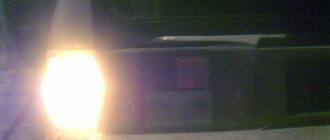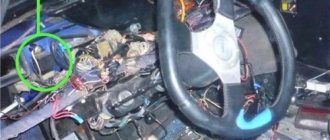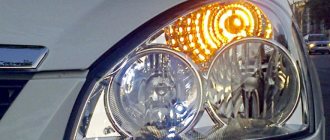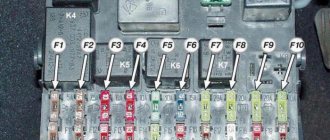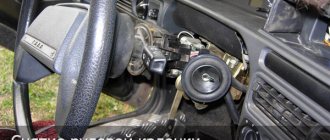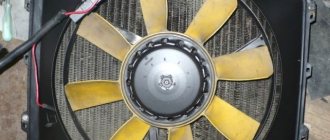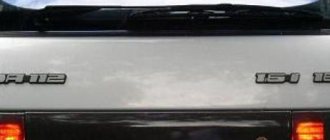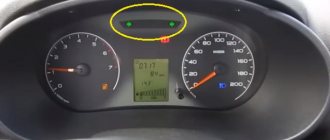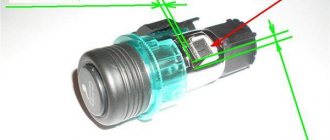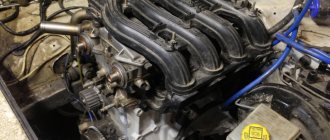January 22, 2016 Lada.Online 149 852 64
Many owners of a Lada Priora, Grant or Kalina 2 are faced with a malfunction in the direction indicators. Based on past experience, they begin to look for the cause of the failure with the relay or fuse, but they cannot find them. Let's look at how the turn signal circuit diagram works and the procedure for troubleshooting.
Checking the serviceability of the turn relay.
First, make sure that the measuring instruments and control lamps on the instrument panel are working.
If they do not work, then check the fuse. If the devices are working properly, turn on the hazard warning button and check that all the lamps in the direction indicators are blinking. This will allow you to divide the circuit into two parts and speed up troubleshooting. If the alarm does not work when turned on, then it is necessary to check the serviceability of the turn and alarm relay and the presence of power at its terminal 49. The pin designation is marked on the bottom of the relay, next to the contact legs.
We remove the relay, which is marked in the form of a triangle on the top of the case, from the mounting block, and in the vacated socket, using a test paw, check for the presence of a plus on pin 49. We connect the test lamp to the ground or minus of the battery, and with the other end we touch pin 49, when If the hazard warning button is on, you do not need to turn on the ignition. Lack of power indicates a faulty fuse, alarm button or broken wires, contact tracks of the mounting block and poor contact in the connectors.
If there is a plus on the terminal, then connect terminals 49 and 49A with a copper wire. If the connecting wires and connectors are in good condition, all the direction indicator lamps should light up. This indicates that the turn signal and light signaling relay is faulty.
If the lamps do not light up, but there is a plus on pin 49, then there may be a short circuit in the signal lamp circuit and the fuse has blown. A short circuit can also cause the relay to fail. In this case, check the serviceability of the fuse, and if it blows, eliminate the short circuit in the signal lamp circuit.
Tips for extending the life of your wipers
There are more radical methods for restoring the operation of windshield wipers, including:
- sanding;
- mechanical sharpening.
However, it is better for inexperienced drivers not to resort to this technique, otherwise there is a risk of permanently damaging the brushes without the slightest possibility of restoring them.
You can also turn to the experts, but most likely, their services will cost the same price as the cost of new wipers. To increase the service life of windshield wipers, it is necessary to regularly care for them, removing any dirt in a timely manner, and also not leaving the car for a long time under the scorching rays of the sun.
In addition, it is not recommended to save on such products, as well as on glass cleaning solutions, the quality of which also determines the lifespan of the element.
Checking the hazard warning button.
If the hazard warning lights are working, then the turn signal and hazard warning relays are working properly, but the fault may be in the hazard warning light button. First, check the plus, as described earlier at pin 49 of the relay, with the hazard warning button off and the ignition on.
If there is no plus, then you need to check the serviceability of the alarm button. To do this, you need to remove the button from the socket by prying it off with a thin screwdriver or remove the instrument panel visor. In the contact connector of the button, use a test lamp to check the presence of power at pin 2 (the numbering of pins on the button near the contacts) with the ignition on.
If there is no power, repair the broken wire from the instrument panel to the button. If there is power, connect pin 2 to pin 5 in the button socket, with the ignition on, and turn on the direction indicators of either side. If the warning lights on this board light up, replace the faulty hazard warning button.
If the warning lights do not light up, then, without removing the jumper from the hazard warning button block, connect pins 49 and 49A with a copper wire in the relay socket, then check the power at pin 49A of the turn switch. To do this, remove the steering column cover and the connecting connector from the turn switch. You can also remove the switch itself to determine the pin numbers that are marked on its lower part next to the contact legs.
This is not difficult to do by squeezing the latches on the sides of the switch and pulling it to the side. If the circuit from the relay to the switch is in good condition, the indicator lamp will start to light. If the control lamp does not light, then repair the break in the wire from the mounting block to the turn signal connector.
When turning on the turns, the fuse blows.
Another malfunction of the direction indicators is the fuse blowing when the indicators of one of the sides are turned on. To quickly identify a malfunction, turn on the hazard warning lights. The signal lamp in a circuit that has a short circuit will not light up or will burn at full intensity. A sign of a short circuit in the signal lamp circuit can be a buzzing sound from the turn signal relay when the indicators are turned on. To facilitate troubleshooting when the VAZ direction indicators do not work, use the diagrams below.
Turn signals and emergency lights in combination on a VAZ-2110
When operating a car, its owner may encounter various system malfunctions, including failure of turn signals to work. They may either not turn on or not turn off. There are different reasons.
Verification algorithm
- All lamps. If one lamp does not work, check it and the wires suitable for it. In rear turn signals, the printed tape and connector often “moody”.
- Fuse F16 or F19.
- Relay.
- Mass on turn signals.
- Understeering's shifter.
The steering column switch is checked by checking the contacts.
- Wiring.
Source
Posts 8
1 Topic by Admin 2012-10-02 05:01:15
- Admin
- Administrator
- Inactive
- Registration: 2012-02-20
- Messages: 3,257 Thanks : 623
Topic: Turn signals do not return automatically
Solution if the turn signals do not return to their place automatically https://xn--2111-43da1a8c.xn--p1ai/tunin... mmment-2412
Auto turn signal stops working
If the turn signals do not return to their place automatically, it is the white plastic ring on the steering wheel that holds the cams when rotating.
Turn signals do not work on VAZ 2112
If you look at the electrical diagram of the direction indicators of the VAZ-2112 passenger car, it is not difficult to guess that it is interconnected with the alarm circuit. These two systems have one common relay K3, located in the mounting block. It is significantly larger in size compared to other nearby relays. Also, these electrical circuits have one common 10-amp fuse F16. The reason for the failure of the direction indicators to work may be the burnout of one of the three lamps installed on the right or left side of the car. The driver is warned about the presence of such a malfunction by a warning light on the instrument panel that stops blinking. When replacing a burnt-out lamp, be sure to install a new lamp of the same power.
The turn signals will not work if relay K3 fails. This malfunction, in principle, can be determined by ear, since when the lever under the steering switch is moved to one of the on positions, the inoperative relay K3 will not emit characteristic clicks, which are heard only when a short circuit is made within its contacts. When replacing a failed relay, it is advisable to install exactly the same one that is installed at the VAZ automobile plant. Its marking is 145P, and relays marked up to 100P are counterfeit and they may be immediately faulty or their service life will be very short.
More complex malfunctions of the direction indicators of a VAZ-2112 car are also possible. One such case is when the turn signal lamps turn on dimly when they are turned on. This can lead to the fact that on a bright sunny day, when they are turned on, they will not be visible to other road users, which can create an emergency situation or even lead to an accident.
This malfunction is associated with a decrease in voltage at the terminals of the lamps, as a result of which their filament does not heat up to the required temperature. And you will have to look for this malfunction in the mounting block. To do this, you will have to remove and disassemble it, and then carefully inspect one of the jumpers on the board going to connector Ш3. Due to the fact that this jumper is small in size, and through it voltage is supplied to a large number of consumers, which leads to a voltage drop at the terminals of the direction indicator lamps when they are turned on. To eliminate this problem, you need to duplicate this jumper by soldering an additional copper wire.
Source
Problems with the elastic band
The elastic band can be replaced or cut. |Photo: .
Problems with rubber bands can be solved in one of two ways. The first one is expensive, but reliable. The second is budget and compromise. With the first method, everything should be extremely clear - we go to the store, buy new wiper blades there, install them and drive away happy.
The second method is not as good and involves additional work, but it will save money. It is necessary to trim the worn-off layer of elastic. This can be done either using improvised means or using a special (and inexpensive) device. Some brushes can be trimmed several times, significantly extending their service life.
Turn signals of VAZ 2112 16 valves do not work reasons
The hazard warning button also affects the turn signals. it was so
The hazard warning button also affects the turn signals. it was so
My connector came off from the turn switch (which is on the steering wheel). Try to stick it in.
it seems that if the horn is buzzing, then it has nothing to do with it.
People, help. I went to work in the morning, everything worked perfectly, all lane changes, turns - the turn signals were blinking normally, I took a turn into the parking lot at work - it didn’t work, not left, not right, the emergency lights were fine, what to look at. I think it’s the paddle shifters or some kind of contact, but I want to know specifically. For about a minute, before turning to work, I skidded off the brakes from :*%?%, who considered himself the king of the road and simply rushed across me without showing a turn signal :ooo:
People, help. I went to work in the morning, everything worked perfectly, all lane changes, turns - the turn signals were blinking normally, I took a turn into the parking lot at work - it didn’t work, not left, not right, the emergency lights were fine, what to look at. I think it’s the paddle shifters or some kind of contact, but I want to know specifically. For about a minute, before turning to work, I skidded off the brakes from :*%?%, who considered himself the king of the road and simply rushed across me without showing a turn signal :ooo:
I have a similar problem and can't figure it out. When you turn on the turn signals, the bottom of the panel (high carb) the lights begin to blink (suction, oil pressure, etc.) and the radio flickers. But when you turn on the emergency lights, there is no such thing. Where to dig.
Moderators, please delete the repetitions, there are problems with the gateway on the site, so it was updated
This applies to the VAZ 2115; for other cars the check will be slightly different.
I also had a problem with turn signals. The hazard lights work, but the turns do not. I went to the service. At first they said the relay, but I changed it, then they said that the fuse in the emergency lamp had blown, but it was new. Then they removed the CY and said that the diode bridge under the relay had burned out, but this also confused me and I told them to dig further. As a result, when they screwed the crank back in, they began to pull the wiring that goes from the crank to the steering wheel and VOILA, everything worked!
Then the problem repeated itself again when I was doing something in the torpedo. The solution was the following: I pulled the wires and everything worked.
Source
How can you tell if your brushes are bad?
Not only the comfort of driving, but also its safety depends on the cleanliness of the windshield, because it increases control over the situation on the road. You can determine that the windshield wiper blades have deteriorated by the following signs:
- Stripes and lines. The rubber part may become damaged or harden over time.
- Vibration. Hardened brushes increase vibration of the cleaner.
- Noise. Noisy wipers are a sign of hardening of the rubber parts. This will lead to faster wear of the fastener and changes in the structure of the blade.
If you are concerned about one or more of the described symptoms, then do not rush to change your windshield wiper blades. First, try restoring your wipers using one of the methods described below. This may help save you on buying new supplies.
Why don't the emergency lights and turn signals work on the VAZ-2112?
Car : VAZ-2112. Asks : Sokolov Vladislav. The essence of the question : the emergency lights and turn signals on the VAZ-2112 do not work, what should I do?
Hello! I came across this problem. I left the garage, everything was fine, the police stopped me at the intersection and fined me for non-working turn signals . I'm at a loss, why, the weather is good, nothing should get stuck? I started to figure it out, checked the relays and fuses, they turned out to be normal.
Tell me, who had this problem, where to look? As I understand it, there is no contact, maybe the problem is in the block? Two weeks ago I changed the steering wheel . The unit was dismantled, the contacts are not scorched, there is no burning smell. What do you recommend, go to a service center or would it be easier and cheaper to buy a new unit, but what if it’s not the cause?
How to restore slots on wipers
And again about the banal...
A couple of months ago I was returning home along Yaroslavka, driving 90 kilometers, it was raining like a wall, the left lanes, the wipers were working with all their resources. And suddenly the driver’s wiper remains lying behind the counter in the area of the left mirror. Turn signal, go to the side of the road...at this moment I need to go to the side of the road, into a puddle 50 cm deep and an area of 20 square meters, with the driver's window down (I was smoking at that moment). After a couple of seconds, a truck passing nearby covers the entire car with a wave higher than the car itself. The expression on my face can only be conveyed by the very expression of my face at that moment. Well, okay, the wipers worried me much more at that moment. I drive away and start to see what's going on. Everything turned out to be very trivial: the slots and threads in the place where the wipers were attached to the trapezoid were worn out. Shamanic songs and dances on the spot did not bring success. The remaining 30 km. I drove with a windshield wiper in my hand, periodically sticking my hand out of the window and doing the work that the trapezoid was supposed to do. Arriving home, I began to think about repairing or buying a new trapezoid, my dear and beloved Toad dissuaded me from buying it, she just said: “No, I won’t give two thousand for a piece of iron.”
Relay or fuse?
The diagram shows the fuse box. The arrows indicate the relays and fuses for the hazard warning lights and turn signals. The VAZ-2110 may have a different mounting block.
First, check fuse F16. After relay K3.
Symptoms of a faulty relay
When idling, the turn signal signal on the instrument panel fades. If so, then the relay is already faulty.
Video text
Regarding cooperation: ► Today we will change the steering column switches on a VAZ 2114 (four).
►You can help with funds to restore the four: https://www.donationalerts.ru/r/akenot. ►Or Sber Online - transfer by phone number +79221048785 Sergey Alexandrovich
Turn me around completely
Hi all. I'm Akeno Tsukiko and I make various videos on my channel. I'll be glad if you subscribe. https://goo.gl/Ycr8Sb - My vk https://goo.gl/etJfpE - Public vk https://goo.gl/4LsqW5 - Tradeoffer steam https://goo.gl/90buOx - Subscribe to my channel https://goo.gl/BUrQKs - Live channel https://goo.gl/wDiWFm - My Instagram
If you want to support me financially: YaD: 410013243271076 QIWI: +79221048785
Theme Options
Search by topic
Troubleshooting if turns do not work, even if you do not have special knowledge.
Checking the serviceability of the turn relay.
And so let’s look at what to do if the turns of a front-wheel drive VAZ, except for the 2170 Priora, do not work. The operation and troubleshooting of which was discussed in the article “Prior Turning Relay”.
First, make sure that the measuring instruments and control lamps on the instrument panel are working. If they do not work, then check the fuse.
If the devices are working properly, turn on the hazard warning button and check that all the lamps in the direction indicators are blinking. This will allow you to divide the circuit into two parts and speed up troubleshooting.
If the alarm does not work when turned on, then it is necessary to check the serviceability of the turn and alarm relay and the presence of power at its terminal 49. The pin designation is marked on the bottom of the relay, next to the contact legs.
We remove the relay, which is marked in the form of a triangle on the top of the case, from the mounting block, and in the vacated socket, using a test paw, check for the presence of a plus on pin 49. We connect the test lamp to the ground or minus of the battery, and with the other end we touch pin 49, when If the hazard warning button is on, you do not need to turn on the ignition. Lack of power indicates a faulty fuse, alarm button or broken wires, contact tracks of the mounting block and poor contact in the connectors.
If there is a plus on the terminal, then connect terminals 49 and 49A with a copper wire. If the connecting wires and connectors are in good condition, all the direction indicator lamps should light up. This indicates that the turn signal and light signaling relay is faulty. If the lamps do not light up, but there is a plus on pin 49, then there may be a short circuit in the signal lamp circuit and the fuse has blown. A short circuit can also cause the relay to fail. In this case, check the serviceability of the fuse, and if it blows, eliminate the short circuit in the signal lamp circuit.
Checking the hazard warning button.
If the hazard warning lights are working, then the turn signal and hazard warning relays are working properly, but the fault may be in the hazard warning light button. First, check the plus, as described earlier at pin 49 of the relay, with the hazard warning button off and the ignition on.
If there is no plus, then you need to check the serviceability of the alarm button. To do this, you need to remove the button from the socket by prying it off with a thin screwdriver or remove the instrument panel visor. In the contact connector of the button, use a test lamp to check the presence of power at pin 2 (the numbering of pins on the button near the contacts) with the ignition on. If there is no power, repair the broken wire from the instrument panel to the button. If there is power, connect pin 2 to pin 5 in the button socket, with the ignition on, and turn on the direction indicators of either side. If the warning lights on this board light up, replace the faulty hazard warning button.
If the warning lights do not light up, then, without removing the jumper from the hazard warning button block, connect pins 49 and 49A with a copper wire in the relay socket, then check the power at pin 49A of the turn switch. To do this, remove the steering column cover and the connecting connector from the turn switch. You can also remove the switch itself to determine the pin numbers that are marked on its lower part next to the contact legs. This is not difficult to do by squeezing the latches on the sides of the switch and pulling it to the side. If the circuit from the relay to the switch is in good condition, the indicator lamp will start to light. If the control lamp does not light, then repair the break in the wire from the mounting block to the turn signal connector.
If repairs are enough...
If the cause of the malfunction is, for example, a worn bushing, then you can limit yourself to repairing the windshield wiper trapezoid. Having unscrewed the wiper arms, carefully dismantle them. Be extremely careful and avoid sudden movements during repairs, as it is very easy to damage the paintwork on the hood edge.
Then the frill and retaining rings are removed, after which the windshield wiper trapezium can be pulled out quite easily. The repair kit has everything you need that can be replaced, so you just need to use it. In some cases, new bushings need to be drilled out (if there is no repair kit for your car model). Be sure to cool the drill regularly, otherwise the sleeve will become deformed when exposed to high temperatures. Then we disassemble the old mechanism.
If you need to adjust the sleeve to length, you can do this using a file. At the same time, be sure to make sure that there is space left for the retaining ring and washer, so periodically try on the new part on the old axle. The assembly of the trapezoid and its installation after repair are carried out in the reverse order. As a result of such work, the play of the windshield wiper blades will disappear, they will fit tightly to the glass and, accordingly, cope with their functions perfectly.
Topic in the “Audi Repair” section, created by SamFM, July 31, 2011.
When turning on the turns, the fuse blows.
Another malfunction of the direction indicators is the fuse blowing when the indicators of one of the sides are turned on. To quickly identify a malfunction, turn on the hazard warning lights. The signal lamp in a circuit that has a short circuit will not light up or will burn at full intensity. A sign of a short circuit in the signal lamp circuit can be a buzzing sound from the turn signal relay when the indicators are turned on. To facilitate troubleshooting when the VAZ direction indicators do not work, use the diagrams below.
Source
